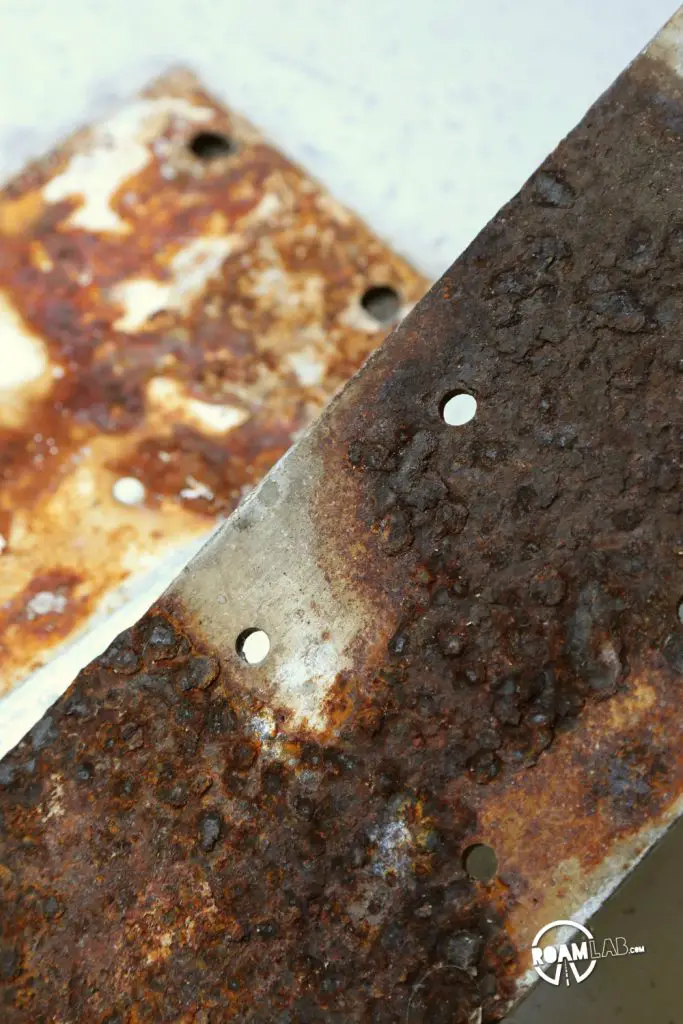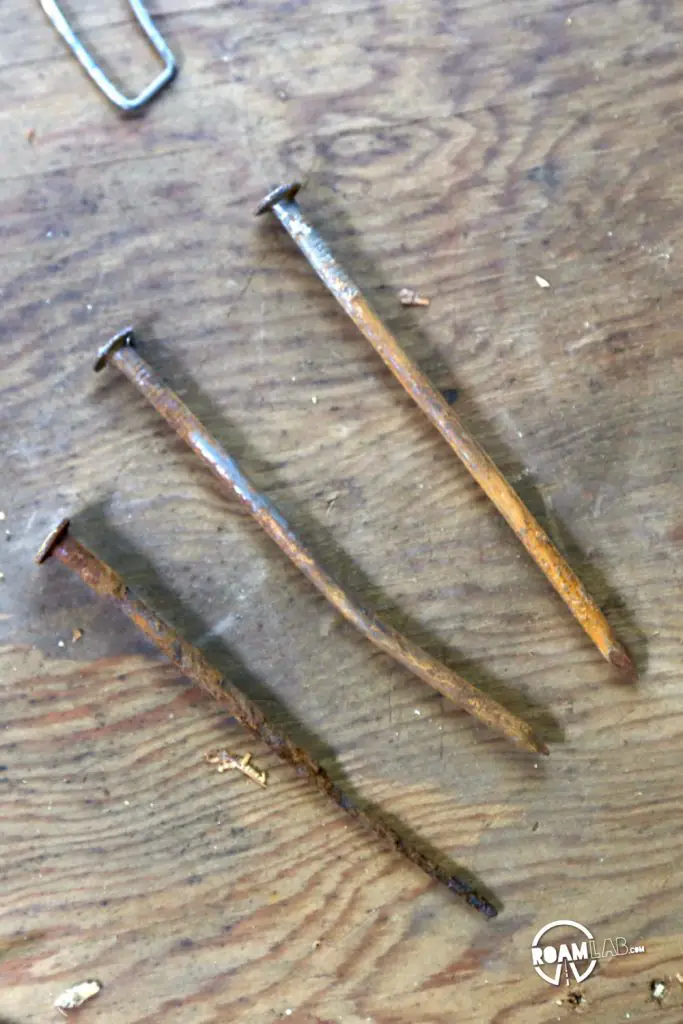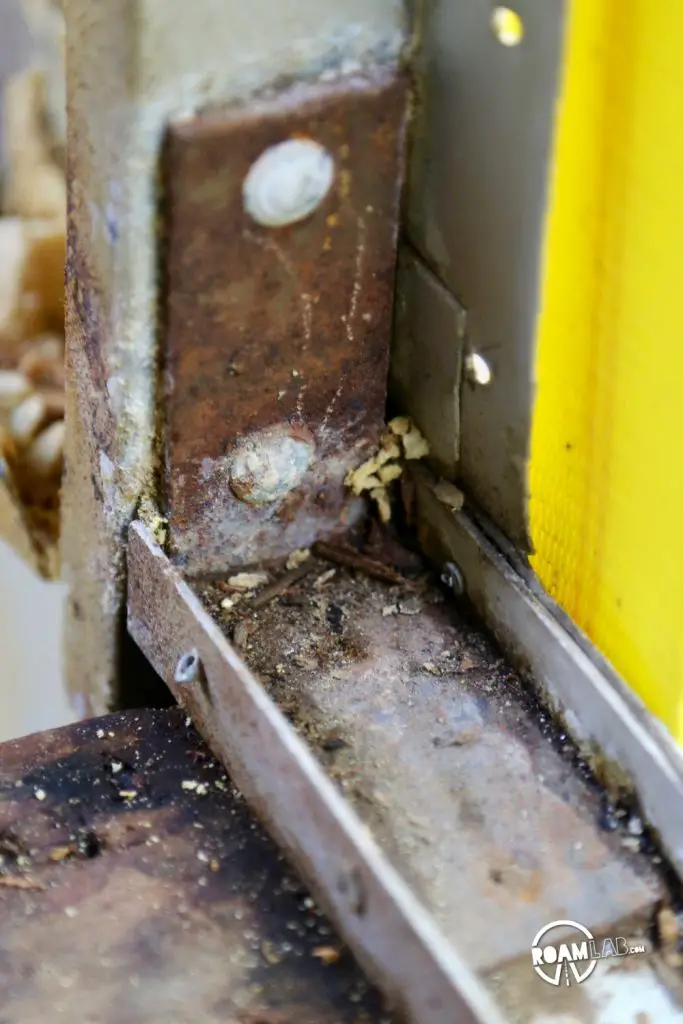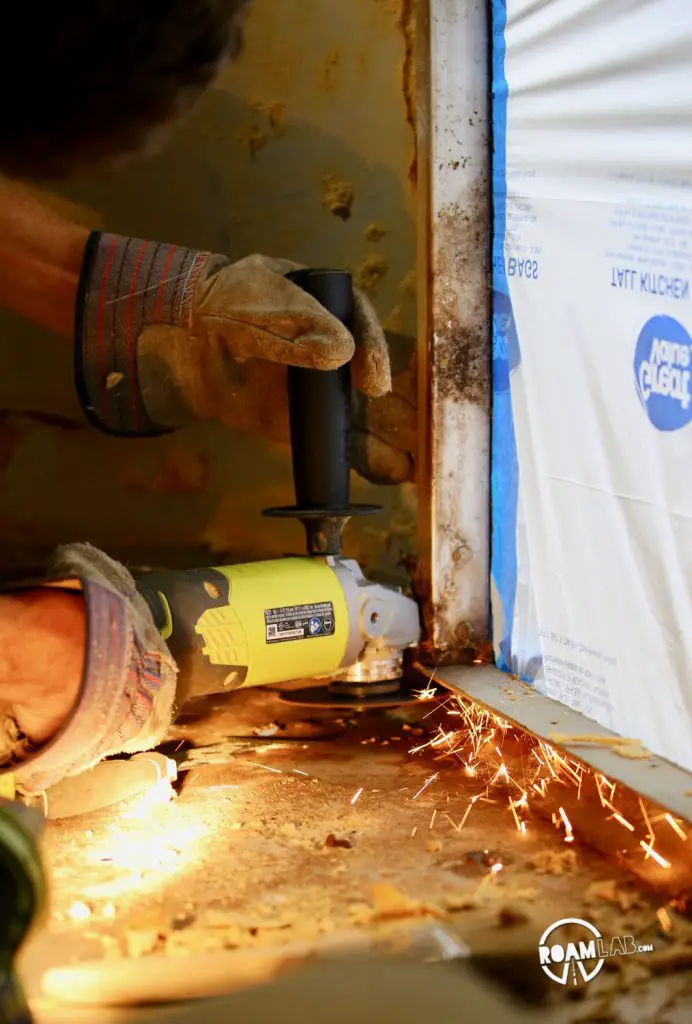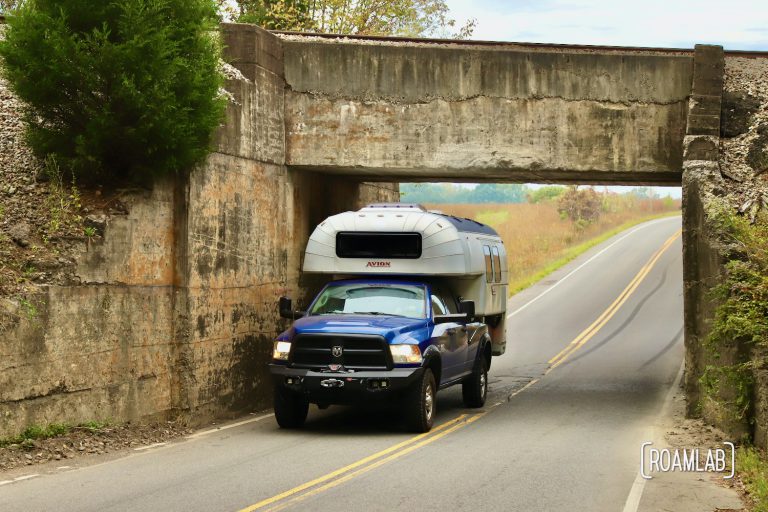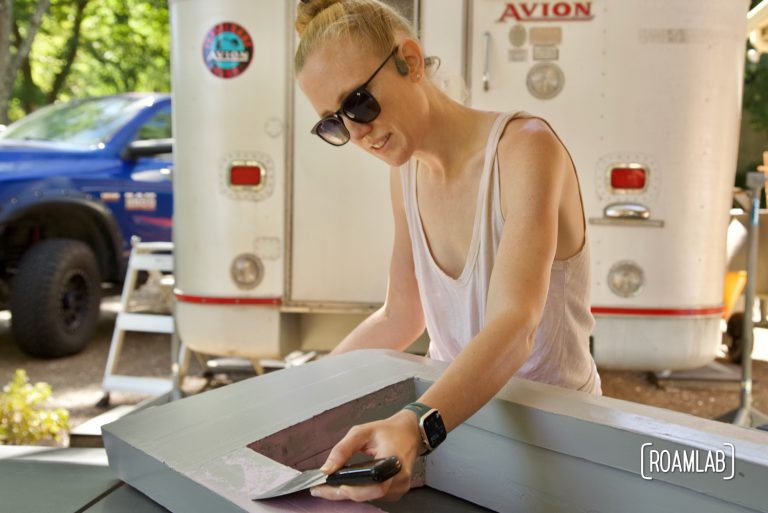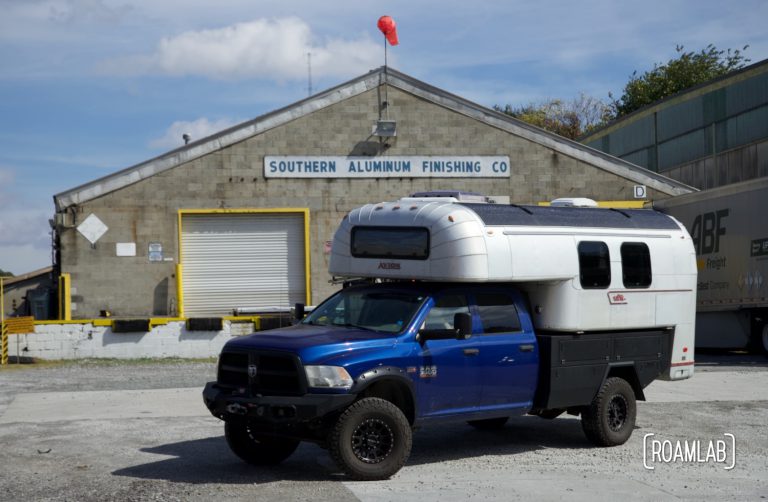Do you have a vintage Airstream, Avion, Spartan, or another aluminum-bodied camper? Ever noticed screw heads covered in rust or pitting in aluminum around a steel screw? You, my friend, are the victim of galvanic corrosion. And if you don’t want to make it worse, you’ll want to know a thing or two about how this happens and how to avoid it.
What is Galvanic Corrosion?
When two dissimilar metals come into electrical contact, something has to give. Give electrons. This electrical contact doesn’t have to be anything near as sever as intentionally running a current between the metals. It is a pretty natural process, exacerbated by exposure to the elements. In such scenarios, one metal will be sacrificed to the other. Which metal that is depends on their ranking relative to each other and the severity varies by their degree of difference. We see that sacrifice as corrosion.
ANODIC – active
- Magnesium alloys
- Zinc
- Beryllium
- Aluminum 1100, 3003, 3004, 5052, 6053
- Galvanized steel
- Cadmium
- Aluminum 2017, 2024, 2117
- Mild Steel (1018), Wrought Iron
- Cast iron, Low alloy high strength steel
- Chrome iron (active)
- Stainless steel, 430 series (active)
- Stainless steel 302, 303, 304, 321, 347, 410, 416, (active)
- Nickel (resist)
- Stainless steel 316, 317, (active)
- Carpenter 20 CB-3 stainless (active)
- Aluminum Bronze (CA 687)
- Hastelloy C (active), Inconel 625 (active), titanium (active)
- Lead-tin solders
- Lead
- Tin
- Inconel 600 (active)
- Nickel (active)
- Brasses (naval, yellow, red, admiralty)
- Copper (CA102)
- Manganese bronze, tin bronze
- Silicon bronze
- Nickel silver
- Copper-nickel alloy
- 430 stainless steel
- Nickel (passive), aluminum, bronze
- Monel 400, K500
- Silver solder
- Nickel (passive)
- Chrome iron (passive)
- 302, 303, 304, 321, 347, stainless steel (passive)
- 316, 317, stainless steel (passive)
- Carpenter 20 CB-3 stainless (passive), Incoloy 825
- Nickel-molybdeum-chromium-iron alloy (passive)
- Silver
- Titanium and titanium alloys
- Graphite
- Zirconium
- Gold
- Platinum
Cathodic – passive
Based on list from Preservation Science
Here, I have a list of common metals arranged by most anodic to most cathodic. Whenever two dissimilar metals come in contact, the more anodic metal will corrode. Thus, the zinc coated screws in our Avion camper were so rusted and brittle that they broke when we attempted to unscrew them. In comparison, the aluminum surface bound to the steel jack points on the wing of the camper are etched in rust. (A more recently applied stainless steal screw is surrounded by pitting in the aluminum sheet.)
Cathodic. Anodic. It’s all Relative.
The relative difference between cathodic and anodic metals will also vary in the severity of the corrosion. For example, rather than using pure steal for components, which rusts easily, many steal components come with a zinc coating. You can see the difference: zinc coated steal has a blueish tint. As the difference between zinc and aluminum is far less than steal and aluminum, there is far less corrosion and, in fact, the zinc will sacrifice to the aluminum rather than aluminum sacrificing to the steal. But, here is the rub: that zinc coating will wear off over time. At that point, the already highly corrosive steal will come in direct contact with aluminum and all hell breaks loose. That is why it is important to look for early signs of corrosion. If zinc coated steal components are starting to corrode, they aren’t zinc coated anymore. That means it’s time to replace the the components with new, zinc-y ones. Early detection makes a huge difference!
Finding Metal In Odd Places
Even wood treated with copper, mercury, or fluoride based preservatives can increase the risk of corrosion for aluminum sheet. So it is very important to know your materials!
Galvanic Corrosion in Fasteners
This is the most common form of Galvanic Corrosion that you are likely to encounter in vintage campers. Idealy, the fastener and base metals are the same. In our Avion, most are. They are called rivets. But there are other scenarios where screws, nails, and other metal components will be needed that aren’t suited for aluminum or whatever the base metal may be. Each role demands different characteristics. What matters is that the difference between the metal types is managed to minimize corrosion. When using different base and fastener metals, the base should be more annodic and the fastener should be more cathodic. The table below demonstrates a range of relationships between cathodic and annodic materials.
| Base Metal | Fastener Metal | |||||
|---|---|---|---|---|---|---|
| Zinc & Galvanized Steel | Aluminum & Aluminum Alloys | Steel & Cast Iron | Brasses, Copper, Bronzes, Monel | Martensitic Stainless (Type 410) | Austenitic Stainless Steel (Type 302/304, 303, 305) | |
Key○ Corrosion of the base metal is not increased by the fastener ◐ Corrosion of the base metal is marginally increased by the fastener ● Corrosion of the base metal is markedly increased by the fastener ⦾ Plating on the fastener is rapidly consumed, leaving the bare fastener metal ⦿ Corrosion of the fastener is increased by the base metal Based on chart from Preservation Science |
||||||
| Zinc & Galvanized Steel | ○ | ◐ | ◐ | ● | ● | ● |
| Aluminum & Aluminum Alloys | ○ | ○ | ◐ | ● | Not Recommended | ◐ |
| Steel & Cast Iron | ○⦾ | ○ | ○ | ● | ● | ◐ |
| Teme (Lead Tin) Plated Steel Sheets | ○⦾⦿ | ○⦿ | ○⦿ | ● | ● | ◐ |
| Brassess, Copper, Bronzes, Monel | ○⦾⦿ | ○⦿ | ○⦿ | ○ | ○ | ◐ |
| Ferritic Stainless Sheet (Type 430) | ○⦾⦿ | ○⦿ | ○⦿ | ○ | ○ | ○ |
| Austenitic Stainless Steel (Type 302/304) | ○⦾⦿ | ○⦿ | ○⦿ | ○⦿ | ○ | ○ |
Making Up The Difference
Even when two different metals come in contact, that contact can be minimized. The severity of the galvanic corrosion is based on the relative difference between the cathodic and anodic materials, the exposure to a current (such as salt water), and surface area. Once the metals are selected, one can still minimize the later two variables—environment and surface area. Indoor metals or painted metals are protected from salt water and other environmental variables that could creative a current. Using plastic washers on screws or rubber mats between metals surfaces can insulate the metals from each other and cut down on the amount of surface area that is in contact.
What We Did
Aluminum screws are expensive. When 1½” screws costs 65¢ each, a project on the scale of ours is overwhelmed just by the price of fasteners. That isn’t to say we skimped on screws. Type 316 Marine Grade Stainless Steal screws are remarkably resistant to corrosion and a 1½” screw costs 16.5¢. What distinguishes type 316 stainless steal from other, already hearty 300 Series austenitic stainless steel is the presence of 2–3% molybdenum, giving it exceptional corrosion resistance. To further minimize risk of corrosion, we used plastic washers to limit the contact between stainless steal and aluminum.
Arguably more important, though, are the L brackets and jack points. After all, these represent a far larger surface area than screws. Some of the worst corrosion observed on the camper are at these points. For this reason, we are replacing all steel L brackets with aluminum. While aluminum jack points aren’t really an option, we can minimize the surface area exposure by introducing a rubber mat between the aluminum skin and the stainless steal jack point.
Have we solved the galvanic corrosion puzzle? Only time will tell.
More Reading On Galvanic Corrosion
- “Preventing Galvanic Corrosion,” Preservation Science



